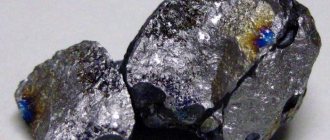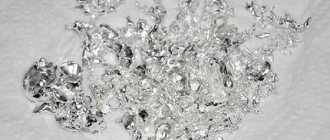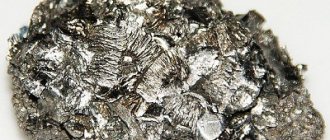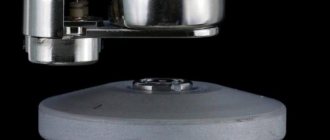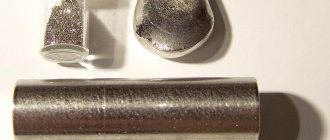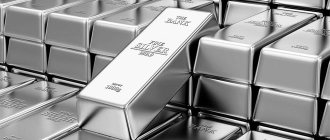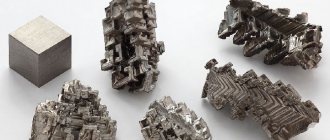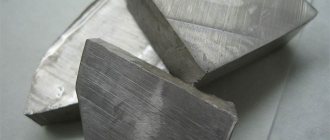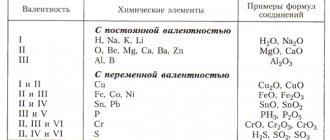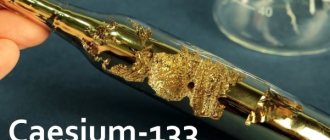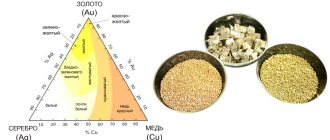History of discovery
The history of the discovery of metal is “multi-part”:
- The first to discover it (1801) while studying lead raw materials was the Mexican mineralogist Manuel Del Rio. However, European chemists did not believe in the discovery. Under their pressure, Del Rio himself began to doubt. And he voiced a new version: it was lead chromate.
- Almost 30 years later it was “rediscovered” by Nils Sefström. A Swedish chemist discovered a new substance while studying iron ore.
- Friedrich Wöhler is considered one of the “fathers”. He studied the same Mexican raw materials, but interrupted his work due to illness. But later he put an end to it, proving that the ore did contain vanadium. Thus, Del Rio’s priority was confirmed.
The name also didn’t come up right away:
- The discoverer Manuel Del Rio, marveling at the variety of colors of the substance, proposed the name “panchromium”. The second option is “erythronium”.
- The beauty of the coloring of the new element was also appreciated by Jens Berzelius and Sefström. The Scandinavians, as expected, proposed their own version - named after the goddess of the Scandinavian pantheon Freya (analogous to the Greek Venus). In Old Norse it sounds like Vanadis.
Geologist George Featherstonhaugh tried to pay tribute to the discoverer of Del Rio.
He proposed renaming the element "rionium", but did not find support.
Vanadium demand
The price of vanadium on the world market is determined by China, the leader in the production of this metal. Taking into account the world production demand for this type of metal, its cost is constantly growing.
- The price per kilogram is determined by the type of final product. The most expensive items include strip and wire, and vanadium pentoxide closes the list.
- When sorting scrap metal, vanadium cannot be detected in its pure form. But you should know that it is part of steels marked “F”.
- In addition, vanadium is part of various wastes, parts and assemblies, in the production of which alloys and various metal-based compounds are used.
Physico-chemical characteristics
The metal is indifferent to the effects of air, water, and alkaline solutions. This inertness makes noble gases (argon, xenon, helium, krypton) similar to vanadium.
Basic properties of metal:
- Dissolves with aqua regia, hydrofluoric acid, hot concentrated nitric and sulfuric acids.
- It is plastic, the threshold for brittleness is +300°C.
- Impurities of nitrogen, oxygen, and hydrogen make metal brittle.
- The substance compounds are toxic.
The following vanadium oxides are known:
| Systematic name | Chem. formula | Density, g/cm³ | Melting point, °C | Boiling point, °C | Molar mass, g/mol | Color |
| Vanadium(II) oxide | V.O. | 5,76 | ~1830 | 3100 | 66,94 | Black |
| Vanadium(III) oxide | V2O3 | 4,87 | 1967 | 3000 | 149,88 | Black |
| Vanadium(IV) oxide | VO2 | 4.571 g/cm³ | 1542 | 2700 | 82,94 | Dark blue |
| Vanadium(V) oxide | V2O5 | 3,357 | 670 | 2030 | 181,88 | Red-yellow |
This is a typical transition metal: it is endowed with variable oxidation states and forms complex compounds. 84 vanadium compounds have been registered, the main ones being oxides, vanadates, and sulfides.
| Properties of the atom | |
| Name, symbol, number | Vanadium (V), 23 |
| Atomic mass (molar mass) | 50.9415(1) a. e.m. (g/mol) |
| Electronic configuration | [Ar] 3d3 4s2 |
| Atomic radius | 134 pm |
| Chemical properties | |
| Covalent radius | 122 pm |
| Ion radius | (+5e)59 (+3e)74 pm |
| Electronegativity | 1.63 (Pauling scale) |
| Electrode potential | 0 |
| Oxidation states | 5, 4, 3, 2, 0 |
| Ionization energy (first electron) | 650.1 (6.74) kJ/mol (eV) |
| Thermodynamic properties of a simple substance | |
| Density (at normal conditions) | 6.11 g/cm³ |
| Melting temperature | 2160 K (1887 °C) |
| Boiling temperature | 3650 K (3377 °C) |
| Ud. heat of fusion | 17.5 kJ/mol |
| Ud. heat of vaporization | 460 kJ/mol |
| Molar heat capacity | 24.95 J/(K mol) |
| Molar volume | 8.35 cm³/mol |
| Crystal lattice of a simple substance | |
| Lattice structure | cubic body-centered |
| Lattice parameters | 3.024 Å |
| Debye temperature | 390 K |
| Other characteristics | |
| Thermal conductivity | (300 K) 30.7 W/(m K) |
| CAS number | 7440-62-2 |
Metal oxides of different valences differ in color: black (II III), deep blue (IV), orange (V).
Pure metal production
The final product in the production of vanadium without impurities can be in the form of powder or ingots (pieces).
Vanadium in the form of metal powder is produced by electrolytic refining. The raw material in this production is aluminothermic vanadium. The final product, depending on the degree of its purity, is divided into three grades:
- Val-1 (purity 99.9%);
- Val-2 (99.7%);
- Val-3 (99.5%).
The technology for manufacturing lump metal requires the use of special electron beam furnaces. The installation for smelting ingots is equipped with two types of guns: thermionic and VTR devices. The working process is based on the method of drip smelting into a crystallizer, which is continuously cooled with water. The crystallizer is placed vertically, and copper is used for its manufacture.
Technical requirements for pieces of pure vanadium are regulated by TU 48-4-272-73. Ingots must have the shape of cylinders, their weight is limited to 8 to 80 kg. The length ranges from 20 to 80 cm, and the diameter can be 80, 100, 120 and 150 mm.
Depending on the presence of foreign impurities, three grades of lump vanadium are distinguished:
- VnM-0 (maximum purity 99.99%);
- VnM-1 (99.9%);
- VnM-2 (99.5%).
Being in nature
The metal is not a rare element: it is the 20th most abundant element on the planet.
Each ton of the earth's crust contains on average 260 g of vanadium.
This is a dispersed element, not present in nature in free form:
- The main source of vanadium as a metal is igneous rocks (basalts, gabbros), bauxites, and iron ores.
- Its compounds have been detected in ocean water. Metal is extracted from it, for example, by the Japanese.
- The most exotic source of metal is ascidians. These sea creatures suck metal right out of the water.
SEM image of vanadium crystals obtained by electrolysis.
Their growth has been put on stream in Japan. Plantations are set up on the coast, the collected “harvest” is dried and burned.
Sea squirt ash is richer in vanadium than most terrestrial deposits.
Extraction: from ore, ascidians and fly agarics ⛏️
The main deposits are owned by:
- China;
- SOUTH AFRICA;
- USA;
- Russia;
- Armenia.
The leader in vanadium production is China, which dictates prices for the metal.
Interesting: the Japanese clearly demonstrated the Russian proverb “need for invention is cunning.” Inventive residents of the Land of the Rising Sun breed ascidians (sea chordates) on special sea plantations. These animals contain more vanadium than many of its ores. And the unfortunate ascidians are burned and the tasty metal is extracted from the ashes.
Some fly agarics are also very rich in vanadium. So in our forests it is possible to mine a valuable element.
We recommend: CESIUM - a metal with an explosive character
Receiving technology
The main supplier of the substance is iron ores with an admixture of vanadium.
The metal product is obtained in several ways:
- Thermal reduction of oxide from carbonates, calcium and magnesium compounds.
- Thermal decomposition of vanadium iodide.
High purity (95-99%) of the product is achieved by refining. For this purpose, electrolysis of the melt of substance halides and vacuum melting are used.
Vanadium bars of 99.95% purity, obtained by melting in an electron beam. The surface of the bars is etched to reveal the structure
Russian scientists have created nanosized modifications of vanadium oxide.
Our shooter is everywhere ⚙️
The use of vanadium and its compounds is limited by a rather high price. But in many cases these substances are simply necessary.
Almost all vanadium (according to various sources, from 87% to 90%) is used by ferrous and non-ferrous metallurgy.
According to statistics, vanadium is the leader among alloying metals. Used to impart the required properties to alloys.
SEM image of vanadium crystals obtained by electrolysis
Vanadium master alloy imparts wear resistance to alloys and improves the toughness and strength of alloys.
All properties of the valuable metal have not yet been studied; Metallurgists and scientists are finding more and more attractive characteristics of Vanadis metal.
Interesting: “If there were no vanadium, there would be no car.” G. Ford, the “father” of the US automobile industry. By the way, he is the smartest person and has unconventional thinking. It was he who uttered the brilliant phrase “Remember that God created man without spare parts.”
The remaining percentages are used:
- Automotive industry;
- electronics;
- producers of sulfuric acid (as a catalyst instead of very expensive platinum);
- in lithium batteries and batteries;
- during oil cracking;
- production of paints and ceramics.
Vanadium compounds are used in nuclear-hydrogen energy.
Vanadium bars of 99.95% purity, obtained by melting in an electron beam. The surface of the bars is etched to reveal the structure
The variety of vanadium compounds is used in the production of fabrics for dyeing.
War requires gunpowder, and its production requires sulfuric acid.
Areas of use
The properties of vanadium have determined its demand by the civilian and military industrial complex.
Metallurgy
Metallurgy takes 90% of raw materials. Here the main way of using vanadium is as an alloy additive to steels:
- Thanks to it, steel and titanium alloys are made stronger, tougher, more elastic, and more resistant to wear, corrosion, and heat.
The advantages of steels with vanadium were appreciated by the “father” of the American automobile industry, Henry Ford, at the beginning of the 20th century.
- Products include rolled products (rods, wire, sheets, tubes), ingots, and powder.
The Russian nomenclature of steels provides for the marking of vanadium in their composition with the letter F.
- There are coated options for regions with extreme climates.
The most popular metal compounds are alloys with titanium and chromium. The latter is used to make hand tools (for example, wrenches, knives).
Chromium in alloys reduces the toxicity of vanadium.
Other industries
Metals and alloys are used in a wide range of operations and products:
- engines of aircraft, rockets, and other space technology;
- permanent magnets;
- lithium batteries, accumulators;
- oil cracking.
It is also used in atomic-hydrogen energy (nuclear reactors) as a chemical current source.
This is a durable pigment for varnishes, paints, ceramics, textiles, glass.
One mass part of vanadium pentoxide is enough to brightly color 200 thousand parts of colorless aniline salt.
Military-industrial complex
Metal compounds are catalysts in the production of sulfuric acid.
It is the source for creating nitro-fiber. And nitrocellulose is the main component of gunpowder.
In the “powder” segment, vanadium has replaced elite platinum.
Vanadium compounds
Vanadium pentoxide used to make Li-ion batteries
The electronic formula of vanadium determines its oxidation state, which ranges from +2 to +5. The most valuable of the metal oxides is vanadium pentoxide, which is in demand in the manufacture of lithium batteries. In the form of a bright orange powder, the compound acts as an anode.
Other vanadium compounds are used in the form of:
- sulfides;
- fluorides;
- chlorides
Vanadium oxides are in demand in industrial production.
General information:
| 100 | General information | |
| 101 | Name | Vanadium |
| 102 | Former name | |
| 103 | Latin name | Vanadium |
| 104 | English name | Vanadium |
| 105 | Symbol | V |
| 106 | Atomic number (number in table) | 23 |
| 107 | Type | Metal |
| 108 | Group | Amphoteric, transitional, ferrous metal |
| 109 | Open | Andres Manuel del Rio Fernandez, Mexico, 1801, Nils Gabriel Sefström, Sweden, 1830 |
| 110 | Opening year | 1801 |
| 111 | Appearance, etc. | Ductile metal, silver-gray |
| 112 | Origin | Natural material |
| 113 | Modifications | |
| 114 | Allotropic modifications | |
| 115 | Temperature and other conditions for the transition of allotropic modifications into each other | |
| 116 | Bose-Einstein condensate | |
| 117 | 2D materials | |
| 118 | Content in the atmosphere and air (by mass) | 0 % |
| 119 | Content in the earth's crust (by mass) | 0,019 % |
| 120 | Content in seas and oceans (by mass) | 1,5·10-7 % |
| 121 | Content in the Universe and space (by mass) | 0,0001 % |
| 122 | Abundance in the Sun (by mass) | 0,00004 % |
| 123 | Content in meteorites (by mass) | 0,0061 % |
| 124 | Content in the human body (by weight) | 3,0·10-6 % |
Characteristic valency and oxidation state
Due to the presence of three unpaired electrons in the 3d sublevel, vanadium can exhibit a +3 oxidation state. However, she is not the only one. There are four possible values in total:
- +2;
- +3;
- +4;
- +5.
Moreover, vanadium is a chemical element, the valence of which also has two indicators: IV and V. That is why this atom has simply many compounds, and they all have a beautiful color. Aqueous complexes and metal salts are especially famous for this.
Features of the structure of the atom
Vanadium is a chemical element whose atomic structure is expressed by the general electronic formula 3d34s2. Obviously, due to this configuration, both the valence and the oxidation state can exhibit different values.
This formula allows us to predict the properties of vanadium as a simple substance - it is a typical metal that forms a large number of different compounds, including complex ones.
Signs of Deficiency
It is too early to say with 100% certainty that vanadium deficiency is dangerous for the human body. Nevertheless, there is an opinion that the lack of this microsubstance provokes:
- complications in diabetics;
- hypoglycemia (sharp decrease in blood glucose);
- development of cancer;
- tendency to cardiovascular diseases;
- increased cholesterol.
Best materials of the month
- Coronaviruses: SARS-CoV-2 (COVID-19)
- Antibiotics for the prevention and treatment of COVID-19: how effective are they?
- The most common "office" diseases
- Does vodka kill coronavirus?
- How to stay alive on our roads?
But it is important to note that laboratory experiments with the exclusion of vanadium from the diet were carried out only on animals. In them, a deficiency of the substance led to a deterioration in the condition of bone tissue, cartilage, muscles, and a decrease in the ability to reproduce. An experiment conducted on goats showed that a lack of vanadium provokes miscarriages, stillbirths, and abnormal fetal development. An experiment was also conducted on rats: after introducing vanadium into the animals’ diet, their thyroid gland performance improved.
Signs of vanadium deficiency in people are only a theory. In addition, if you adhere to a balanced diet, it is almost impossible to become deficient in micronutrients. The exception is impaired digestive function and problems with the absorption of nutrients.
